Hit Generation in TB Drug Discovery: From Genome to Granuloma
- PMID: 29384369
- PMCID: PMC5832989
- DOI: 10.1021/acs.chemrev.7b00602
Hit Generation in TB Drug Discovery: From Genome to Granuloma
Erratum in
-
Correction to Hit Generation in TB Drug Discovery: From Genome to Granuloma.Chem Rev. 2019 Jun 26;119(12):7718. doi: 10.1021/acs.chemrev.9b00244. Epub 2019 May 6. Chem Rev. 2019. PMID: 31058490 Free PMC article. No abstract available.
Abstract
Current tuberculosis (TB) drug development efforts are not sufficient to end the global TB epidemic. Recent efforts have focused on the development of whole-cell screening assays because biochemical, target-based inhibitor screens during the last two decades have not delivered new TB drugs. Mycobacterium tuberculosis (Mtb), the causative agent of TB, encounters diverse microenvironments and can be found in a variety of metabolic states in the human host. Due to the complexity and heterogeneity of Mtb infection, no single model can fully recapitulate the in vivo conditions in which Mtb is found in TB patients, and there is no single "standard" screening condition to generate hit compounds for TB drug development. However, current screening assays have become more sophisticated as researchers attempt to mirror the complexity of TB disease in the laboratory. In this review, we describe efforts using surrogates and engineered strains of Mtb to focus screens on specific targets. We explain model culture systems ranging from carbon starvation to hypoxia, and combinations thereof, designed to represent the microenvironment which Mtb encounters in the human body. We outline ongoing efforts to model Mtb infection in the lung granuloma. We assess these different models, their ability to generate hit compounds, and needs for further TB drug development, to provide direction for future TB drug discovery.
Conflict of interest statement
The authors declare the following competing financial interest(s): T. Y. and N. S. S. are named inventors on patents and patent applications related to this article.
Figures
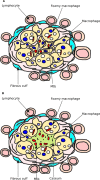
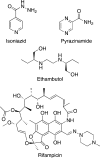
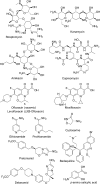
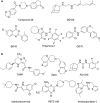

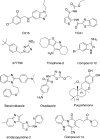
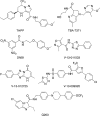

Similar articles
-
Host-directed therapy targeting the Mycobacterium tuberculosis granuloma: a review.Semin Immunopathol. 2016 Mar;38(2):167-83. doi: 10.1007/s00281-015-0537-x. Epub 2015 Oct 28. Semin Immunopathol. 2016. PMID: 26510950 Free PMC article. Review.
-
Editorial: Current status and perspective on drug targets in tubercle bacilli and drug design of antituberculous agents based on structure-activity relationship.Curr Pharm Des. 2014;20(27):4305-6. doi: 10.2174/1381612819666131118203915. Curr Pharm Des. 2014. PMID: 24245755
-
The pursuit of mechanism of action: uncovering drug complexity in TB drug discovery.RSC Chem Biol. 2021 Apr 1;2(2):423-440. doi: 10.1039/d0cb00226g. Epub 2021 Jan 13. RSC Chem Biol. 2021. PMID: 33928253 Free PMC article.
-
[Development of antituberculous drugs: current status and future prospects].Kekkaku. 2006 Dec;81(12):753-74. Kekkaku. 2006. PMID: 17240921 Review. Japanese.
-
Harnessing Biological Insight to Accelerate Tuberculosis Drug Discovery.Acc Chem Res. 2019 Aug 20;52(8):2340-2348. doi: 10.1021/acs.accounts.9b00275. Epub 2019 Jul 30. Acc Chem Res. 2019. PMID: 31361123 Free PMC article. Review.
Cited by
-
Novel hybrids of 1,2,3-triazole-benzoxazole: design, synthesis, and assessment of DprE1 enzyme inhibitors using fluorometric assay and computational analysis.J Enzyme Inhib Med Chem. 2024 Dec;39(1):2403744. doi: 10.1080/14756366.2024.2403744. Epub 2024 Sep 27. J Enzyme Inhib Med Chem. 2024. PMID: 39329328 Free PMC article.
-
Antitubercular, Cytotoxicity, and Computational Target Validation of Dihydroquinazolinone Derivatives.Antibiotics (Basel). 2022 Jun 21;11(7):831. doi: 10.3390/antibiotics11070831. Antibiotics (Basel). 2022. PMID: 35884084 Free PMC article.
-
Polyketide Synthase 13 (Pks13) Inhibition: A Potential Target for New Class of Anti-tubercular Agents.Curr Top Med Chem. 2024;24(27):2362-2376. doi: 10.2174/0115680266322983240906055750. Curr Top Med Chem. 2024. PMID: 39297467 Review.
-
Recent Advances of DprE1 Inhibitors against Mycobacterium tuberculosis: Computational Analysis of Physicochemical and ADMET Properties.ACS Omega. 2022 Nov 3;7(45):40659-40681. doi: 10.1021/acsomega.2c05307. eCollection 2022 Nov 15. ACS Omega. 2022. PMID: 36406587 Free PMC article. Review.
-
Mce3R Stress-Resistance Pathway Is Vulnerable to Small-Molecule Targeting That Improves Tuberculosis Drug Activities.ACS Infect Dis. 2019 Jul 12;5(7):1239-1251. doi: 10.1021/acsinfecdis.9b00099. Epub 2019 May 3. ACS Infect Dis. 2019. PMID: 31012313 Free PMC article.
References
-
- WHO “Global Tuberculosis Report 2016”, World Health Organization, 2017 ; http://www.who.int/tb/publications/global_report/en/ accessed: 29 September 2017.
-
- CDC “Tuberculosis Fact Sheets”, Centers for Disease Control and Prevention, 2014 ; https://www.cdc.gov/tb/publications/factsheets/general/ltbiandactivetb.htm accessed: 22 December 2017.
-
- WHO “Collaborative Framework for Care and Control of Tuberculosis and Diabetes”, World Health Organization , 2017; http://www.who.int/tb/publications/tb-diabetes-framework/en/ accessed: 5 January 2018. - PubMed
-
- WHO “Multidrug-Resistant Tuberculosis (MDR-TB) 2016 Update”, World Health Organization, 2016 ; http://www.who.int/tb/challenges/mdr/mdr_tb_factsheet.pdf accessed: 29 September 2017.
Publication types
MeSH terms
Substances
Grants and funding
LinkOut - more resources
Full Text Sources
Other Literature Sources

